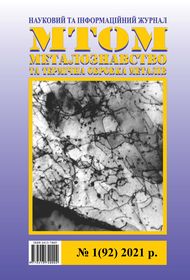Defects of the hardened layer at laser exposure
DOI:
https://doi.org/10.30838/J.PMHTM.2413.230321.7.729Abstract
Purpose. It is necessary to investigate the influence of non-metallic inclusions on the formation of defects during laser processing. The aim of the work was to study the defects of the hardened layer of steels under laser action, associated with the presence of non-metallic inclusions. Methods. The materials for investigation were commercial steels containing different non-metallic inclusions. The specimens of different steels with preliminary polished surface were exposed to laser beaming on the installations GOS-30M and GUANTUM-16. The research methods were applied - petrography, X-ray microscopy (MS-46 Cameca) and optical microscopy (Neophot-21) to study defects and identify of inclusions. Results. It has been established that various types of defects appear on the surface and in the surface layer of steel under laser action, which are not connected and are associated with non-metallic inclusions. It is shown that non-metallic inclusions are the reason for the appearance of various kinds of defects in the hardened layer of steel products during laser processing (cracks, cavities, violation of the geometry of the hardened layer). The reasons for the appearance of defects associated with the presence of inclusions of various types are discussed. Scientific novelty. A classification of defects in the hardened layer is presented. The nature and features of the formation of defects, associated with the appearance of high-speed thermal stresses, structural inhomogeneity, as well as melting, thermal destruction and evaporation of inclusions emerging to the surface and located within the hardened layer, have been established. It is noted that the detected defects are ready-made centers of destruction of a steel product or part under conditions of static and dynamic loads, as well as contact stresses. Practical significance. It is shown that the unsatisfactory quality of the hardened layer associated with the presence of various kinds of defects near nonmetallic inclusions contributes to a decrease in the mechanical and operational characteristics of a steel product. The use of the obtained results will make it possible to develop technologies for laser processing of steels with regulated quality parameters of the hardened layer, which will prevent the formation of various kinds of defects.
Keywords: steel; laser treatment; defects; cracks; hardened layer; non-metallic inclusions

Downloads
Published
Versions
- 2021-05-11 (4)
- 2021-05-11 (1)
Issue
Section
License
Authors that are published in this journal agree to follow the conditions:
Authors reserve the right to the authorship of his work and cede the right to the journal of first publication of this work on conditions of the license under the Creative Commons Attribution License, which allows others to distribute it freely with the obligatory reference to the author of the original work and the first publication of the work in this journal.
